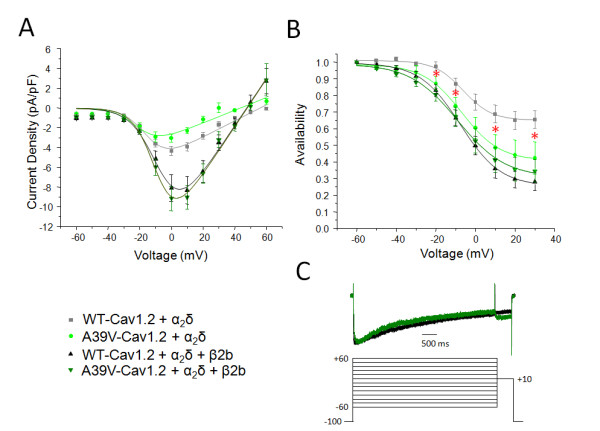Figure 2.

The current voltage relation and steady-state inactivation of A39V-Cav1.2 is not significantly different from WT-Cav1.2 in the presence of β2b or β1b. (A). The current-voltage relationships of WT and A39V-Cav1.2 with and without β2b. There is no significant difference in current density, or voltage-dependent properties when comparing WT-Cav1.2 (grey) and A39V-Cav1.2 (light green); or WT-Cav1.2 (black) and A39V-Cav1.2 (dark green) with Cavβ2b. Cavβ2b does significantly increase the current density of both WT and A39V-Cav1.2 (p = < 0.05 by one-way ANOVA). β1b also significantly increased current density of A39V-Cav1.2 (p = < 0.05 by one-way ANOVA) (Additional file 2: Figure S2). (B). Steady-state inactivation plots of WT and A39V-Cav1.2 with and without β2b. There is no significant difference in the steady-state of inactivation between WT-Cav1.2 and A39V-Cav1.2 in the presence of β2b or β1b (Additional file 2: Figure S2). The slope of steady state inactivation is increased for A39V-Cav1.2 when compared to WT-Cav1.2 in the absence of the Cavβ subunit (see Table 1) which significantly reduces the percentage of channels available at marked voltages (*) when compared to WT (p = < 0.05 by students t-test). (C) Voltage clamp protocol for inactivation curves, and sample traces of WT-Cav1.2 and A39V-Cav1.2 with Cavβ2b. Normalized traces of WT-Cav1.2 (black) and A39V-Cav1.2 (dark green) with Cavβ2b illustrating no significant difference in the time course of inactivation. Currents were evoked from a holding potential of -100 mV to various 4.5 s long conditioning potentials (ranging from -60 mV through +60 mV in 10 mV increments), followed by a test pulse to +10 mV for 0.5 sec.
